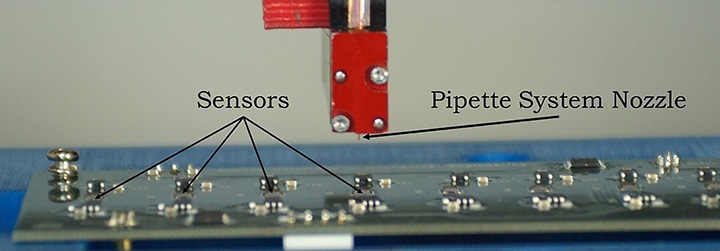Nov 21 2017
Researchers at Purdue University have discovered a technique of identifying biological markers in small quantities of blood that they believe could be applied to detect numerous infections, diseases, and various medical conditions at early stages.
 A piezoelectrically actuated pipette system is used as an inexpensive means to detect biological molecules associated with specific diseases, infection or other medical conditions. Purdue University researchers believe the test could be the early detection of traumatic brain injury in athletes, particularly high school football and soccer players. (Photo credit: Purdue University)
A piezoelectrically actuated pipette system is used as an inexpensive means to detect biological molecules associated with specific diseases, infection or other medical conditions. Purdue University researchers believe the test could be the early detection of traumatic brain injury in athletes, particularly high school football and soccer players. (Photo credit: Purdue University)
Jeffrey Rhoads, a professor in Purdue’s School of Mechanical Engineering; George Chiu, a professor in Purdue’s School of Mechanical Engineering, School of Electrical and Computer Engineering, and Department of Psychological Sciences; and Eric Nauman, a professor in the School of Mechanical Engineering, Department of Basic Medical Sciences and the Weldon School of Biomedical Engineering, are part of a research team that has built microelectromechanical resonators, or small vibrating sensors, capable of detecting these biomarkers using only a drop or two of blood. The plate-style resonant sensors allow sensitive, economical detection of biomarkers that can indicate illness, disease, or trauma.
“The goal here is to find the disease so early that you can treat it without invasive surgery,” Rhoads said. “The test looks for a particular protein related to a disease, so you could use this for the detection of many different diseases.”
The sensors employ a piezoelectrically actuated resonant microsystem, which when triggered by electricity can sense an alteration in mass. The resonator’s sensitivity increases as the resonant frequency increases, making high-frequency resonators exceptional candidates for biomarker detection, Rhoads said. The technique is also a lot faster and less expensive compared to other types of medical tests.
The research paper was published in IEEE Sensors Letters.
Rhoads said they found a way to do the test that identifies a tiny quantity of protein in a very small quantity of blood.
Detecting biomarkers is like trying to find a handful of needles in a large haystack. So we devised a method that divided the large haystack into smaller haystacks, instead of having a single sensor, it makes more sense to have an array of sensors and do statistical-based detection.
Jeffrey Rhoads, a professor in Purdue’s School of Mechanical Engineering
One of the initial applications for the test could be the early detection of traumatic brain injury in athletes, mainly high school soccer and football players. A Purdue research team, known as the Purdue Neurotrauma Group, started examining the effects of head injuries in 2009 and discovered that concussions are typically the result of multiple hits over time and not by a single blow, as universally believed. The group, which includes Nauman and Thomas Talavage, a professor in the schools of Electrical and Computer Engineering and Biomedical Engineering, has analyzed football and women’s soccer at the collegiate and high school levels.
An investigation into the effects of repeated head impacts on high school football players has revealed variations in brain chemistry and metabolism even in players who have not been diagnosed with concussions, Nauman said.
Concussions currently are diagnosed using a string of tests, frequently starting with asking an athlete whether he is aware of where he is or what time it is. Next cognitive tests are done that grade concussion symptoms along a scale. Nauman said that while 5% to 10% of high school football players will be diagnosed with concussions, over 50% of those athletes will experience neurological variations before a concussion is detected. Researchers have learned that a concussion is commonly a buildup of injury and the test they have created can detect the traumatic brain injury prior to it becoming symptomatic.
“You do enough damage, you knock out enough systems and eventually you have symptoms,” Nauman said.
The Purdue test can detect minute quantities of proteins, including protein from glial cells, which surround neurons in the brain. The proteins are secreted in comparatively high concentrations in cerebrospinal fluid of victims of traumatic brain injury. Previous studies have discovered that a small quantity of fluid leaked via the blood-brain barrier and entered into the bloodstream of victims.
“Essentially the idea is that if you can measure anything that passes through the blood-brain barrier from the brain into the blood, it's a problem because it should stay in the brain,” Nauman said.
The test also is economical so a high school football team could undergo several mass screenings a season, Rhoads said. Nauman said the Purdue Neurotrauma Group anticipates testing high school athletes next fall.
The test also could be applied for the early detection of Parkinson’s disease and Alzheimer’s disease, Nauman said. “You can basically look for general neurodegeneration, not just in athletes.”
The researchers trust that the test also could be adapted for detecting innumerable other diseases. They are seeking licensees to use the test to search for other tiny quantities of protein that are early signs of disease.
There’s a whole host of diseases and different conditions where, if you could find these things in small quantities early on and just make it part of a standard workup, you could decrease health-care costs greatly.
Eric Nauman, a professor in the School of Mechanical Engineering
The research team has filed a patent application via the Purdue Research Foundation’s Office of Technology Commercialization.